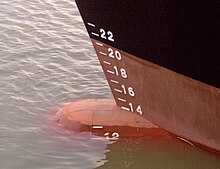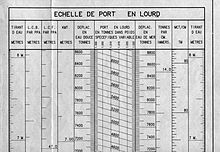

Deadweight tonnage (also known as deadweight; abbreviated to DWT, D.W.T., d.w.t., or dwt) or tons deadweight (DWT) is a measure of how much weight a ship can carry.[1][2][3] It is the sum of the weights of cargo, fuel, fresh water, ballast water, provisions, passengers, and crew.[1]
DWT is often used to specify a ship's maximum permissible deadweight (i.e. when it is fully loaded so that its Plimsoll line is at water level), although it may also denote the actual DWT of a ship not loaded to capacity.
- ^ a b Turpin, Edward A.; William A. McEwen (1980). Merchant Marine Officers' Handbook (4th ed.). Centreville, Maryland: Cornell Maritime Press. pp. 14–21. ISBN 0-87033-056-X.
- ^ Hayler, William B. (2003). American Merchant Seaman's Manual (7th ed.). Centreville, Maryland: Cornell Maritime Press. p. G-10. ISBN 0-87033-549-9.
- ^ Gilmer, Thomas C. (1975). Modern Ship Design (2nd ed.). Naval Institute Press. p. 25. ISBN 0-87021-388-1.